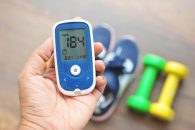Managing Diabetes is important and knowing how to do so will help: How does exercise affect blood sugar levels
Physical activity or exercise, is an important component of a healthy lifestyle. The primary role of exercise in the diabetes management process, is in helping to keep blood glucose levels in, or close to target range. However, knowing how does exercise affect blood sugar levels, is usually contingent on a number of variables such as the type of exercises performed and duration of the exercise program among others. For these reasons, knowing how does exercise affect blood sugar levels can be different for everyone. As many research studies show, the exercise and blood sugar elevation connection is undeniable. The overreaching benefit of exercise, however, is the ability to diminish the occurrence of the debilitating effects of diabetes. For most people with a diabetic condition, exercise is usually a safe option that is highly recommended as a way to help reduce the risk of complications. Yet, according to Sharon Movsas, RD; a diabetes nutrition specialist at the Clinical Diabetes Center at Montefiore Medical Center in New York City; it is one of the most underused treatments.
Some of the beneficial elements between diabetes and exercise were highlighted in a major clinical research study conducted by the National Institute of Diabetes and Digestive Disorders. The focus in this research was the impact of physical activity on prediabetic and diabetic conditions. The results indicated that:
- Physical activity lowered the risk of diabetes by improving the body’s ability to use insulin and process glucose.
- Millions of high-risk people could delay or avoid developing type 2 diabetes by losing weight through regular physical activity and a diet low in fat and calories.
- Participants who lost a modest amount of weight through increased physical activity and dietary changes sharply reduced their chances of developing diabetes.
- Participation in a diabetic prevention program that included exercise and other behavior modifications were able to reduce their risk of developing diabetes by at least 58 percent.
These finding were reportedly true for men and women and across all ethnic groups that participated in the study.
How Does Exercise Affect Blood Sugar Levels?
Exercise that cause muscles to contract help to stimulate a mechanism of action that requires the use of glucose. This heightened sensitivity allows the cells to better utilize any available glucose in the blood. When exercise becomes habituated the body is also more likely to sustain lower hemoglobin A1c levels.
In a review of several studies over a period of years; regular exercise was shown to produce multiple benefits for different types of diabetic conditions such as:
- Control and improve blood glucose levels
- Improve cholesterol levels,
- Improve blood pressure,
- Decrease the risk of cardio-vascular complication
- Improve overall quality of life for the diabetic; and
- Reduce mortality rates for people with this disease
There are however, some caveats that people considering starting an exercise program to help manage diabetes should keep in mind. In some instances, exercise and blood sugar elevation can also increase boost insulin production. For those who administer insulin, this may necessitate a reduction in the amount insulin the body needs. This is an important shift that should be discussed with your doctor.
Diabetes and Exercise
The first step before starting an exercise program for diabetes is to discuss this decision with your primary care physician. The next is to explore the types of exercise that are best for people with diabetes that will also fit into your lifestyle.
Experts from the American College of Sports Medicine and the American Diabetes Association suggest that people with type 2 diabetes establish a regular exercise program that includes moderate to vigorous aerobic activities. The suggested time spent in exercising should be at least three days each week with no more than two consecutive days of non-exercise days in-between. They also recommend a minimum of 150 minutes of physical activity that can be spread out over the course of a week.
When it comes to diabetes and exercise, supervised training is always preferred over an unsupervised program. But whether you participate in a diabetic exercise program or go it alone, it is important to identify and implement safe exercise procedures that are relevant to your diabetic condition.


